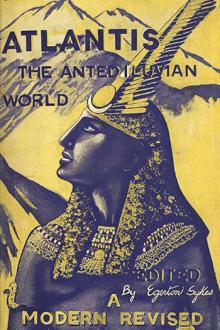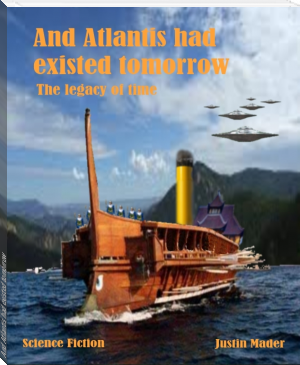Atlantis: The Antedeluvian World by Ignatius Donnelly (thriller novels to read .TXT) 📕

- Author: Ignatius Donnelly
- Performer: -
Book online «Atlantis: The Antedeluvian World by Ignatius Donnelly (thriller novels to read .TXT) 📕». Author Ignatius Donnelly
17. While I do not attach much weight to verbal similarities in the languages of the two continents, nevertheless there are some that are very remarkable. We have seen the Pan and Maia of the Greeks reappearing in the Pan and Maya of the Mayas of Central America. The god of the Welsh triads, “Hu the mighty,” is found in the Hu-nap-bu, the hero-god of the Quiches; in Hu-napu, a hero-god; and in Hu-hu-nap-hu, in Hu-ncam, in Hu-nbatz, semi-divine heroes of the Quiches. The Phœnician deity El “was subdivided into a number of hypostases called the Baalim, secondary divinities, emanating from the substance of the deity” (“Anc. Hist.
East,” vol. ii., p. 219); and this word Baalim we find appearing in the mythology of the Central Americans, applied to the semi-divine progenitors of the human race, Balam-Quitze, Balam-Agab, and Iqui-Balam.
CHAPTER V.
THE QUESTION OF COMPLEXION.
The tendency of scientific thought in ethnology is in the direction of giving more and more importance to the race characteristics, such as height, color of the hair, eyes and skin, and the formation of the skull and body generally, than to language. The language possessed by a people may be merely the result of conquest or migration. For instance, in the United States to-day, white, black, and red men, the descendants of French, Spanish, Italians, Mexicans, Irish, Germans, Scandinavians, Africans, all speak the English language, and by the test of language they are all Englishmen; and yet none of them are connected by birth or descent with the country where that language was developed.
There is a general misconception as to the color of the European and American races. Europe is supposed to be peopled exclusively by white men; but in reality every shade of color is represented on that continent, from the fair complexion of the fairest of the Swedes to the dark-skinned inhabitants of the Mediterranean coast, only a shade lighter than the Berbers, or Moors, on the opposite side of that sea.
Tacitus spoke of the “Black Celts,” and the term, so far as complexion goes, might not inappropriately be applied to some of the Italians, Spaniards, and Portuguese, while the Basques are represented as of a still darker hue. Tylor says (“Anthropology,” p. 67), “On the whole, it seems that the distinction of color, from the fairest Englishman to the darkest African, has no hard and fast lines. but varies gradually from one tint to another.”
And when we turn to America we find that the popular opinion that all Indians are “red men,” and of the same hue from Patagonia to Hudson’s Bay, is a gross error.
Prichard says (“Researches into the Physical History of Mankind,” vol.
i., p. 269, 4th ed., 1841):
“It will be easy to show that the American races show nearly as great a variety in this respect as the nations of the old continent; there are among them white races with a florid complexion, and tribes black or of a very dark hue; that their stature, figure, and countenance are almost equally diversified.”
John T. Short says (“North Americans of Antiquity,” p. 189): “The Menominees, sometimes called the ‘White Indians,’ formerly occupied the region bordering on Lake Michigan, around Green Bay. The whiteness of these Indians, which is compared to that of white mulattoes, early attracted the attention of the Jesuit missionaries, and has often been commented on by travellers. While it is true that hybridy has done much to lighten the color of many of the tribes, still the peculiarity of the complexion of this people has been marked since the first time a European encountered them. Almost every shade, from the ash-color of the Menominees through the cinnamon-red, copper, and bronze tints, may be found among the tribes formerly occupying the territory cast of the Mississippi, until we reach the dark-skinned Kaws of Kansas, who are nearly as black as the negro. The variety of complexion is as great in South America as among the tribes of the northern part of the continent.”
In foot-note of p. 107 of vol. iii. of “U. S. Explorations for a Railroad Route to the Pacific Ocean,” we are told, “Many of the Indians of Zuni (New Mexico) are white. They have a fair skin, blue eyes, chestnut or auburn hair, and are quite good-looking.
They claim to be full-blooded Zunians, and have no tradition of intermarriage with any foreign race. The circumstance creates no surprise among this people, for from time immemorial a similar class of people has existed among the tribe.”
Winchell says:
“The ancient Indians of California, in the latitude of forty-two degrees, were as black as the negroes of Guinea, while in Mexico were tribes of an olive or reddish complexion, relatively light. Among the black races of tropical regions we find, generally, some light-colored tribes interspersed. These sometimes have light hair and blue eyes. This is the case with the Tuareg of the Sahara, the Afghans of India, and the aborigines of the banks of the Oronoco and the Amazon.” (Winchell’s “Preadamites,” p. 185.)
William Penn said of the Indians of Pennsylvania, in his letter of August, 1683:
“The natives . . . are generally tall, straight, well-built, and of singular proportion; they tread strong and clever, and mostly walk with a lofty chin. . . . Their eye is little and black, not unlike a straight-looked Jew. . . . I have seen among them as comely European-like faces of both sexes as on your side of the sea; and truly an Italian complexion hath not much more of the white, and the noses of several of them have as much of the Roman. . . . For their original, I am ready to believe them to be of the Jewish race—I mean of the stock of the ten tribes—and that for the following reasons: first, in the next place, I find them to be of the like countenance, and their children of so lively a resemblance that a man would think himself in Duke’s Place or Berry Street in London when he seeth them. But this is not all: they agree in rites, they reckon by moons, they offer their first-fruits, they have a kind of feast of tabernacles, they are said to lay their altars upon twelve stones, their mourning a year, customs of women, with many other things that do not now occur.”
Upon this question of complexion Catlin, in his “Indians of North America,” vol. i., p. 95, etc., gives us some curious information. We have already seen that the Mandans preserved an image of the ark, and possessed legends of a clearly Atlantean character. Catlin says: “A stranger in the Mandan village is first struck with the different shades of complexion and various colors of hair which he sees in a crowd about him, and is at once disposed to exclaim, ‘These are not Indians.’
There are a great many of these people whose complexions appear as light as half-breeds; and among the women particularly there are many whose skins are almost white, with the most pleasing symmetry and proportion of feature; with hazel, with gray, and with blue eyes; with mildness and sweetness of expression and excessive modesty of demeanor, which render them exceedingly pleasing and beautiful. Why this diversity of complexion I cannot tell, nor can they themselves account for it. Their traditions, so far as I can learn them, afford us no information of their having had any knowledge of white men before the visit of Lewis and Clarke, made to their village thirty-three years ago. Since that time until now (1835) there have been very few visits of white men to this place, and surely not enough to have changed the complexions and customs of a nation. And I recollect perfectly well that Governor Clarke told me, before I started for this place, that I would find the Mandans a strange people and half white.
“Among the females may be seen every shade and color of hair that can be seen in our own country except red or auburn, which is not to be found.
. . . There are very many of both sexes, and of every age, from infancy to manhood and old age, with hair of a bright silvery-gray, and in some instances almost perfectly white. This unaccountable phenomenon is not the result of disease or habit, but it is unquestionably an hereditary characteristic which runs in families, and indicates no inequality in disposition or intellect. And by passing this hair through my hands I have found it uniformly to be as coarse and harsh as a horse’s mane, differing materially from the hair of other colors, which, among the Mandans, is generally as fine and soft as silk.
“The stature of the Mandans is rather below the ordinary size of man, with beautiful symmetry of form and proportion, and wonderful suppleness and elasticity.”
Catlin gives a group (54) showing this great diversity in complexion: one of the figures is painted almost pure white, and with light hair.
The faces are European.
GOVERNOR AND OTHER INDIANS OF THE PUEBLO OF SAN DOMINGO, NEW MEXICO.Major James W. Lynd, who lived among the Dakota Indians for nine years, and was killed by them in the great outbreak of 1862, says (MS. “Hist.
of Dakotas,” Library, Historical Society, Minnesota, p. 47), after calling attention to the fact that the different tribes of the Sioux nation represent several different degrees of darkness of color: “The Dakota child is of lighter complexion than the young brave; this one lighter than the middle-aged man, and the middle-aged man lighter than the superannuated homo, who, by smoke, paint, dirt, and a drying up of the vital juices, appears to be the true copper-colored Dakota. The color of the Dakotas varies with the nation, and also with the age and condition of the individual. It may be set down, however, as a shade lighter than olive; yet it becomes still lighter by change of condition or mode of life, and nearly vanishes, even in the child, under constant ablutions and avoiding of exposure. Those children in the Mission at Hazlewood, who are taken very young, and not allowed to expose themselves, lose almost entirely the olive shade, and become quite as white as the American child. The Mandans are as light as the peasants of Spain, while their brothers, the Crows, are as dark as the Arabs. Dr.
Goodrich, in the ‘Universal Traveller,’ p. 154, says that the modern Peruvians, in the warmer regions of Peru, are as fair as the people of the south of Europe.”
The Aymaras, the ancient inhabitants of the mountains of Peru and Bolivia, are described as having an olive-brown complexion, with regular features, large heads, and a thoughtful and melancholy cast of countenance.





Comments (0)